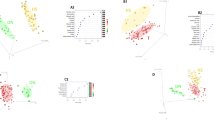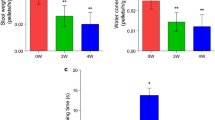Abstract
Basic fibroblast growth factor (bFGF) has a potential role in the treatment of Parkinson’s disease (PD) due to its neurotrophic effect on dopaminergic neurons. To address the metabolic mechanisms of bFGF administration on PD, we have analyzed the metabolic profiles in the striatum of 6-hydroxydopamine (6-OHDA)-induced PD rats after the treatment with bFGF using 1H NMR spectroscopy and partial least squares-discriminant analysis (PLS-DA). In the present study, we found that bFGF treatment can effectively recover PD-induced loss of tyrosine hydroxylase (TH)-positive neurons in the substantia nigra. Metabolomic analyses reveal that PLS-DA failed to discriminate between the control and bFGF groups, indicating that the metabolic difference between these two groups was negligible. However, reliable PLS-DA models can be developed between control and PD groups as well as between PD and bFGF groups, which is attributed to changes in a series of metabolites including GABA, glutamate (Glu), glutamine (Gln), lactate, N-acetylaspartate, creatine, taurine, and myo-inositol. ANOVA results show that the levels of all these metabolites were significantly increased in PD rats relative to normal rats, while PD-induced increase can be significantly reduced to normal levels after bFGF administration. In conclusion, our results suggest that a recovery from PD-induced metabolic disorders may be achieved by bFGF treatment, involving Gln/Glu-GABA cycle, energy metabolism, osmoregulation, and inflammation.



Similar content being viewed by others
Abbreviations
- 6-OHDA:
-
6-Hydroxydopamine
- Ala:
-
Alanine
- bFGF:
-
Basic fibroblast growth factor
- Cho:
-
Choline
- CNS:
-
Central nervous system
- Cre:
-
Creatine
- Eth:
-
Ethanol
- GABA:
-
γ-Aminobutyric acid
- Gln:
-
Glutamine
- Glu:
-
Glutamate
- Lac:
-
Lactate
- MPTP:
-
1-Methyl-4-phenyl-1,2,3,6-tetrahydropyridine
- Myo:
-
Myo-inositol
- NAA:
-
N-acetyl aspartate
- PD:
-
Parkinson’s disease
- PLS-DA:
-
Partial least squares-discriminant analysis
- Suc:
-
Succinate
- Tau:
-
Taurine
- TH:
-
Tyrosine hydroxylase
References
de Lau LM, Breteler MM (2006) Epidemiology of Parkinson’s disease. Lancet Neurol 5(6):525–535
Hornykiewicz O (2006) The discovery of dopamine deficiency in the parkinsonian brain. J Neural Transm 70:9–15
Dauer W, Przedborski S (2003) Parkinson’s disease: mechanisms and models. Neuron 39:889–909
Warner TT, Schapira AH (2003) Genetic and environmental factors in the cause of Parkinson’s disease. Ann Neurol 53(S3):S16–S25
Hauser DN, Hastings TG (2013) Mitochondrial dysfunction and oxidative stress in Parkinson’s disease and monogenic Parkinsonism. Neurobiol Dis 51:35–42
Hwang O (2013) Role of oxidative stress in Parkinson’s disease. Exp Neurobiol 22(1):11–17
More SV, Kumar H, Kim IS, Song SY, Choi DK (2013) Cellular and molecular mediators of neuroinflammation in the pathogenesis of Parkinson’s disease. Mediat Inflamm Article ID: 952375. doi: 10.1155/2013/952375
Fitzmaurice AG, Rhodes SL, Lulla A, Murphy NP, Lam HA, O’Donnell KC, Barnhill L, Casida JE et al (2013) Aldehyde dehydrogenase inhibition as a pathogenic mechanism in Parkinson disease. Proc Natl Acad Sci USA 110(2):636–641
Obeso JA, Rodriguez-Oroz MC, Goetz CG, Marin C, Kordower JH, Rodriguez M, Hirsch EC, Farrer M et al (2010) Missing pieces in the Parkinson’s disease puzzle. Nat Med 16:653–661
Butcher J (2005) Parkin gene therapy could treat Parkinson’s disease. Lancet Neurol 4(2):82
Lindvall O, Björklund A (2004) Cell therapy in Parkinson’s disease. NeuroRx 1(4):382–393
Ferreira JJ, Katzenschlager R, Bloem BR, Bonuccelli U, Burn D, Deuschl G, Dietrichs E, Fabbrini G et al (2013) Summary of the recommendations of the EFNS/MDS-ES review on therapeutic management of Parkinson’s disease. Eur J Neurol 20(1):5–15
Deuschl G, Agid Y (2013) Subthalamic neurostimulation for Parkinson’s disease with early fluctuations: balancing the risks and benefits. Lancet Neurol 12(10):1025–1034
Mena MA, Casarejos MJ, Gimenez-Gallego G, de Yebenes JG (1995) Fibroblast growth factors: structure-activity on dopamine neurons in vitro. J Neural Transm-Parkinson’s Dis Dementia Sect 9(1):1–14
Sanchez-Pernaute R, Lee H, Patterson M, Reske-Nielsen C, Yoshizaki T, Sonntag KC, Studer L, Isacson O (2008) Parthenogenetic dopamine neurons from primate embryonic stem cells restore function in experimental Parkinson’s disease. Brain 131(8):2127–2139
Ratzka A, Baron O, Stachowiak MK, Grothe C (2012) Fibroblast growth factor 2 regulates dopaminergic neuron development in vivo. J Neurochem 122:94–105
Peng J, Xie L, Jin K, Greenberg DA, Andersen JK (2008) Fibroblast growth factor 2 enhances striatal and nigral neurogenesis in the acute 1-methyl-4-phenyl-1, 2, 3, 6-tetrahydropyridine model of Parkinson’s disease. Neurosci 153(3):664–670
Timmer M, Cesnulevicius K, Winkler C, Kolb J, Lipokatic-Takacs E, Jungnickel J, Grothe C (2007) Fibroblast growth factor (FGF)-2 and FGF receptor 3 are required for the development of the substantia nigra, and FGF-2 plays a crucial role for the rescue of dopaminergic neurons after 6-hydroxydopamine lesion. J Neurosci 27(3):459–471
Shults CW, Ray J, Tsuboi K, Gage FH (2000) Fibroblast growth factor-2-producing fibroblasts protect the nigrostriatal dopaminergic system from 6-hydroxydopamine. Brain Res 883(2):192–204
Michell AW, Mosedale D, Grainger DJ, Barker RA (2008) Metabolomic analysis of urine and serum in Parkinson’s disease. Metabolomics 4(3):191–201
LeWitt PA, Li J, Lu M, Beach TG, Adler CH, Guo L (2013) 3-hydroxykynurenine and other Parkinson’s disease biomarkers discovered by metabolomic analysis. Mov Disord 28(12):1653–1660
Roede JR, Uppal K, Park Y, Lee K, Tran V, Walker D, Strobet FH, Rhodes SL et al (2013) Serum metabolomics of slow vs. rapid motor progression Parkinson’s disease: a pilot study. PloS One 8(10):e77629
Trupp M, Jonsson P, Ohrfelt A, Zetterberg H, Obudulu O, Malm L, Wuolikainen A, Linder J et al (1995) N-acetylaspartate in neuropsychiatric disorders. Prog Neurobiol 46(5):531–540
Hatano T, Saiki S, Okuzumi A, Mohney RP, Hattori N (2015) Identification of novel biomarkers for Parkinson’s disease by metabolomic technologies. J Neurol Neurosurg Psychiatry doi: 10.1136/jnnp-2014-309676
Savorani F, Tomasi G, Engelsen SB (2010) icoshift: a versatile tool for the rapid alignment of 1D NMR spectra. J Magn Res 202(2):190–202
Gao HC, Zhu H, Song CY, Lin L, Xiang Y, Yan ZH, Bai GH, Ye FQ et al (2013) Metabolic changes detected by ex vivo high resolution 1H NMR spectroscopy in the striatum of 6-OHDA-induced Parkinson’s rat. Mol Neurobiol 47(1):123–130
Wishart DS, Jewison T, Guo AC, Wilson M, Knox C, Liu YF, Djoumbou Y, Mandal R et al (2012) HMDB 3.0-the human metabolome database in 2013. Nucl Acids Res 41:D801–D807
Schrag A, Jahanshahi M, Quinn N (2000) How does Parkinson’s disease affect quality of life? A comparison with quality of life in the general population. Mov Disord 15(6):1112–1118
Nakashima A, Hayashi N, Kaneko YS, Mori K, Sabban EL, Nagatsu T, Ota A (2009) Role of N-terminus of tyrosine hydroxylase in the biosynthesis of catecholamines. J Neural Transm 116(11):1355–1362
Sidoryk-Wegrzynowicz M, Aschner M (2013) Manganese toxicity in the central nervous system: the glutamine/glutamate-γ-aminobutyric acid cycle. J Intern Med 273(5):466–477
Podell M, Hadjiconstantinou M, Smith MA, Neff NH (2003) Proton magnetic resonance imaging and spectroscopy identify metabolic changes in the striatum in the MPTP feline model of Parkinsonism. Exp Neurol 179(2):159–166
Chassain C, Bielicki G, Keller C, Renou JP, Durif F (2010) Metabolic changes detected in vivo by 1H MRS in the MPTP intoxicated mouse. NMR Biomed 23:547–553
Emir UE, Tuite PJ, Oz G (2012) Elevated pontine and putamenal GABA levels in mild-moderate Parkinson disease detected by 7 tesla proton MRS. PLoS One 7(1):e30918
Coune PG, Craveiro M, Gaugler MN, Mlynarik V, Schneider BL, Aebischer P, Gruetter R (2013) An in vivo ultrahigh field 14.1 T (1) H-MRS study on 6-OHDA and alpha-synuclein-based rat models of Parkinson’s disease: GABA as an early disease marker. NMR Biomed 26:43–50
Bélanger M, Allaman I, Magistretti PJ (2011) Brain energy metabolism: focus on astrocyte-neuron metabolic cooperation. Cell Metab 14(6):724–738
Koga K, Mori A, Ohashi S, Kurihara N, Kitagawa H, Ishikawa M, Misumoto Y, Nakai M (2006) 1H MRS identifies lactate rise in the striatum of MPTP-treated C57BL/6 mice. Eur J Neurosci 23(4):1077–1081
Lowe MT, Kim EH, Faull RL, Christie DL, Waldvogel HJ (2013) Dissociated expression of mitochondrial and cytosolic creatine kinases in the human brain: a new perspective on the role of creatine in brain energy metabolism. J Cereb Blood Flow Metab 33(8):1295–1306
Isaacks RE, Bender AS, Kim CY, Prieto NM, Norenberg MD (1994) Osmotic regulation of myo-inositol uptake in primary astrocyte cultures. Neurochem Res 19(3):331–338
Strange K, Emma F, Paredes A, Morrison R (1994) Osmoregulatory changes in Myo-inositol content and Na+/Myo-inositol cotransport in rat cortical astrocytes. Glia 12(1):35–43
Bagga P, Chugani AN, Varadarajan KS, Patel AB (2013) In vivo NMR studies of regional cerebral energetics in MPTP model of Parkinson’s disease: recovery of cerebral metabolism with acute levodopa treatment. J Neurochem 127(3):365–377
Baslow MH (2003) N-acetylaspartate in the vertebrate brain: metabolism and function. Neurochem Res 28:941–953
Jenkins BG, Klivenyi P, Kustermann E, Andreassen OA, Ferrante RJ, Rosen BR, Beal MF (2000) Nonlinear decrease over time in N-acetyl aspartate levels in the absence of neuronal loss and increases in glutamine and glucose in transgenic Huntington’s disease mice. J Neurochem 74:2108–2119
Demougeot C, Garnier P, Mossiat C, Bertrand N, Giroud M, Beley A, Marie C (2001) N-acetylaspartate, a marker of both cellular dysfunction and neuronal loss: its relevance to studies of acute brain injury. J Neurochem 77:408–415
Tsai G, Coyle JT (1995) N-acetylaspartate in neuropsychiatric disorders. Prog Neurobiol 46(5):531–540
Davies SE, Gotoh M, Richards DA, Obrenovitch TP (1998) Hypoosmolarity induces an increase of extracellular N-acetylaspartate concentration in the rat striatum. Neurochem Res 23(8):1021–1025
Lei S, Powers R (2013) NMR metabolomics analysis of Parkinson’s disease. Curr Metabolomics 1(3):191–209
Acknowledgments
This work was supported by the National Natural Science Foundation of China (Nos.: 21175099, 21575105, 81400863) and Zhejiang Provincial Natural Science Foundation (Nos.: LY13H070005, LY14H090014, LY15H180010).
Author information
Authors and Affiliations
Corresponding authors
Rights and permissions
About this article
Cite this article
Zheng, H., Zhao, L., Xia, H. et al. NMR-Based Metabolomics Reveal a Recovery from Metabolic Changes in the Striatum of 6-OHDA-Induced Rats Treated with Basic Fibroblast Growth Factor. Mol Neurobiol 53, 6690–6697 (2016). https://doi.org/10.1007/s12035-015-9579-2
Received:
Accepted:
Published:
Issue Date:
DOI: https://doi.org/10.1007/s12035-015-9579-2




